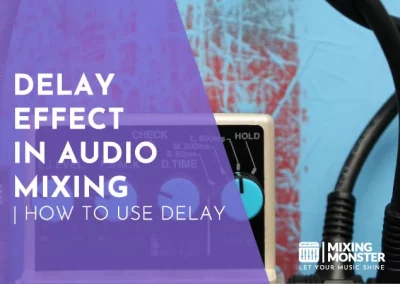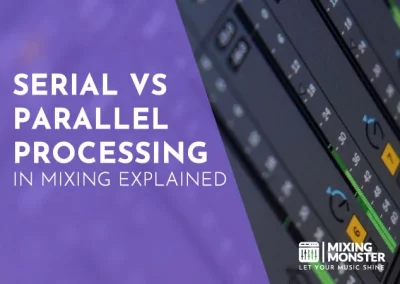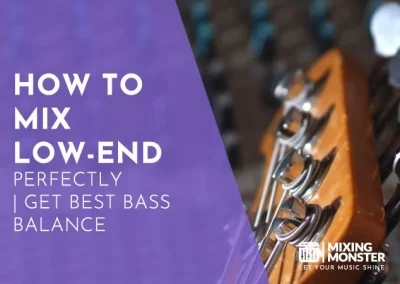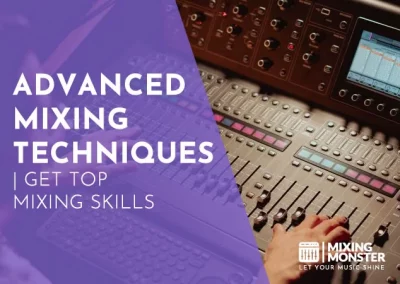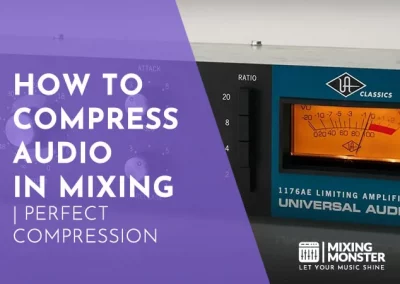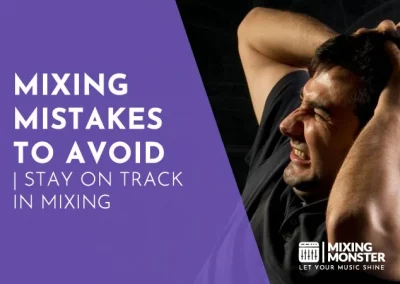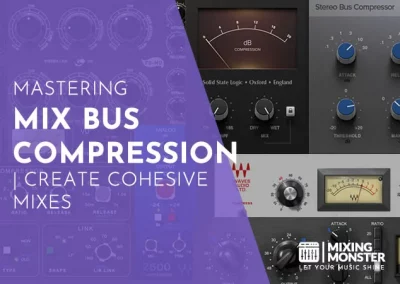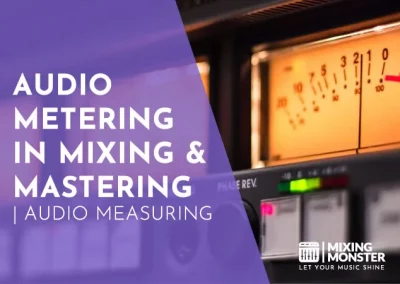Home > Blog > Mixing > Mixing Techniques
Immerse yourself in the transformative world of reverb, the secret ingredient that breathes life into your mix. Our comprehensive reverb effect guide is your gateway to mastering this binding effect, turning flat tracks into resonant soundscapes. Let’s explore the science and art of reverb, and together, let’s create music that genuinely echoes with your audience.
Reverb, short for reverberation, is a sonic phenomenon where sound waves reflect off surfaces, creating a sense of space and depth in audio recordings. It’s a common tool in music production to enhance realism and create ambiance.
Dive deeper into the realm of reverb in audio mixing, where science meets art to transform simple sounds into immersive auditory experiences. Are you ready to unlock the secrets of creating depth and ambiance in your music? Let’s get to it!
Table Of Contents
1. Introduction To Reverb
2. Understanding The Different Types Of Reverb
3. How To Use Reverb Effect In Mixing
4. Advanced Techniques For Reverb Effect
5. Common Mistakes When Using Reverb
6. Reverb Effect Software And Hardware
7. The Echoing Endnote: Using Reverb For Impeccable Mixes
8. FAQ

1. Introduction To Reverb
Welcome to the realm of reverb! Here, we explore how sounds interact with spaces, giving your mix depth and character. But what exactly is reverb, and how does it play into your music production? Let’s dive in.
What Is Reverb Effect?
Reverb, short for reverberation, is the continuation of sound after it’s been produced or reflected. Imagine you’re in a grand cathedral, and you clap your hands.
The sound echoes, bounces off the walls, and gradually fades away. That’s reverb. It adds space and depth to your audio, creating a more realistic listening experience.
The Role Of Reverb In Music Production
In music production, reverb is a crucial player. It serves several functions, including creating a sense of space, adding depth, and making your mix sound more natural.
Without reverb, your music may sound flat and lifeless, like it’s being played in a vacuum. Too much, and it can turn into an indistinct mess. The trick lies in using just the right amount.
How Does The Reverb Effect Work?
Reverb simulates the natural reflections of sound in a space. It takes the original audio signal and creates decaying echoes, miming the sound waves bouncing off different surfaces.
These echoes merge to form a reverb ‘tail’, which gradually fades out. The size and shape of the space, along with the materials it’s made of, influence how the reverb sounds.
From the quietest whispers to the loudest roars, reverb shapes the sound of every audio we hear. Are you ready to learn how to harness the power of reverb in your mixes? Stay tuned.
With this foundation, you’re ready to dive deeper into the world of reverb. Ready to echo your way to better mixes?
2. Understanding The Different Types Of Reverb
Its source doesn’t just determine a sound’s character – the space it reverberates in is equally crucial. Here, we’ll walk you through the different types of reverb that can color your sound.
Room Reverb
Have you ever noticed how your voice sounds different in a bathroom compared to a large hall? That’s room reverb at work. Room reverbs are designed to mimic the sound of smaller, more intimate spaces, like rooms in a house. They have a short decay time and can add warmth and closeness to a mix.
Hall Reverb
Think grand concert halls and cathedrals. Hall reverbs are designed to emulate these more significant, more expansive spaces. They have a longer decay time than room reverbs, providing a sense of depth and grandeur to your music. They’re commonly used on vocals and lead instruments to create a sense of space without muddying the mix.
Plate Reverb
This reverb type mimics the sound of an audio signal being played through a large, thin sheet of metal known as a plate. Plate reverb is prized for its bright, dense character and is often used on vocals and drums to add a sheen that doesn’t interfere with the clarity of the original signal.
Spring Reverb
As the name suggests, Spring reverb uses a spring to create a distinctive, ‘boingy’ sound. This reverb type is often associated with guitar amps and vintage organs, lending a retro vibe to any mix.
Convolution Reverb
A step up in realism, convolution reverb uses digital samples, or ‘impulse responses’, of real-world spaces to create highly accurate reverb effects. Suppose you want your track to sound like it was recorded in a specific scenario like a cathedral, forest, or even a famous recording studio. In that case, convolution reverb is the way to go.
There you have it – a guided tour through the main reverb types. Understanding their differences allows you to add depth, dimension, and atmosphere to your mixes. Next, we’ll explore using these reverb types effectively in your audio mixing.
3. How To Use Reverb Effect In Mixing
Now that we’ve explored the various reverb types let’s dive into how to use them in your mix effectively. Every mix is unique, and different tracks require different treatments. However, some fundamental techniques apply across the board.
Choosing The Right Reverb For Your Track
Choosing the right reverb for your track is crucial. Do you want a lush, grand sound? Try a hall reverb. A room reverb might be your best bet for a more intimate and warm effect. For instance, if you’re mixing a folk song, room reverb could be perfect for the vocals and acoustic guitars to create an intimate and personal feel.
Balancing Dry And Wet Signals
Reverb is typically applied via an aux send/return setup, which allows you to blend the dry (unprocessed) and wet (reverberated) signals. A good starting point might be setting the reverb to send level so the reverb is audible but doesn’t dominate the mix. If the vocal track is the focus, too much reverb might make it sound distant and muddy.
Setting Reverb Time And Size
Reverb time (or decay time) is how long the reverb takes to fade. Size refers to the virtual size of the space. Larger spaces and longer decay times create a more meaningful sense of depth and distance. However, longer is only sometimes better. For a fast-paced rock song, a shorter decay time on the snare might keep the rhythm tight and punchy.
Utilizing Pre-Delay For Depth
Pre-delay is the time gap between the dry signal and the onset of the reverb. A longer pre-delay can make a sound seem further away by creating a gap between the initial sound and its reflections. For example, you might use a longer pre-delay on a lead vocal to make it ‘stand out’ more from the backing track.
Remember, reverb is a tool to enhance your mix, not overpower it. Used judiciously, it can create a sense of depth, space, and realism in your tracks. In the next section, we’ll look at advanced reverb techniques for those who want to dive deeper.
4. Advanced Techniques For Reverb Effect
Now that we’ve covered the basics, let’s delve into more advanced techniques. These can add unique flavors to your mix, helping it to stand out from the crowd.
Layering Reverbs For Unique Soundscapes
Layering different types of reverbs can create a richer, more complex soundscape. For instance, you could use a short room reverb on a vocal to give it some immediacy and then add a touch of hall reverb to create a larger sense of space around it.
Using EQ With Reverb To Avoid Muddiness
Applying EQ to your reverb can prevent it from muddying your mix. A common technique is to use a high-pass filter to remove low-frequency content from the reverb. For example, if you have a dense mix with many instruments, applying EQ to your reverbs can help keep the lower frequencies clear and avoid a boomy or muddy mix.
Sidechaining Reverb For Dynamic Mixes
Sidechain reverb is a technique where the reverb is reduced (via compression) while the dry signal is playing and then allowed to increase when the dry signal stops or decreases. This can be used, for example, on a snare drum to give it a powerful, echoing tail that doesn’t interfere with the impact of the initial hit.
These advanced techniques can help take your mixes to the next level. But remember, the essential rule in mixing is that there are no hard and fast rules. It’s all about what serves the song best. Now, let’s tackle some common mistakes to avoid when using reverb in your mixes.

5. Common Mistakes When Using Reverb
Reverb can add depth and character to a mix but can lead to common pitfalls if not used carefully. Let’s explore some of these potential missteps and how to avoid them.
Overusing Reverb
One of the most common mistakes is overusing reverb. It’s easy to get carried away and end up with a muddy and indistinct mix. Always remember, less is often more. Using reverb sparingly can help maintain clarity and separation between instruments.
Ignoring The EQ While Applying Reverb
Applying a reverb without considering the EQ can lead to a cluttered mix. More low or high frequencies in your reverb can cause a mix to sound muddy or harsh. Remember to EQ your reverb to fit the mix better.
Not Considering The Type Of Reverb For Different Tracks
Each reverb type creates a different effect, so using the same reverb on all tracks may not yield the best results. Try to match the reverb type with the character of the sound. For instance, a bright plate reverb might work well on a snare drum, while a vocal might benefit more from a warmer hall or room reverb.
Overlooking The Pre-Delay Control
Pre-delay can help separate the dry sound and the reverb, but it’s often overlooked. Ignoring this can lead to a mix where everything sounds too distant or washed out. Adjust the pre-delay to fit the tempo and feel of the track.
Inappropriate Use Of Wet/Dry Mix
An improper balance between the wet (reverberated) and dry (direct) signals can negatively affect your mix. A too much wet signal can make the mix sound distant, while too much dry signal might not provide enough sense of space.
Avoiding these common mistakes can improve your reverb usage and lead to better, more transparent mixes. Next, explore some tools you can use to apply reverb in your mixes.
6. Reverb Effect Software And Hardware
Reverb can be implemented using various tools. In the modern digital world, we have many software plugins available. However, hardware units still hold their charm and can deliver unique and distinctive sounds. Let’s explore both options.
Reverb Effect Software
Software-based reverbs have become a staple in modern music production, offering many choices. They are affordable, versatile, and convenient to use.
Top Free Reverb Plugins
-
- TAL-Reverb-4:
A high-quality plate reverb with a simple, intuitive interface. - ValhallaSupermassive:
An excellent plugin for creating ambient and modulated space effects. - Voxengo OldSkoolVerb:
Emulates the classic stereo verb algorithm, providing a vintage feel.
- TAL-Reverb-4:
Premium Reverb Plugins For Professional Productions
-
- FabFilter Pro-R:
Offers a musical approach with easy-to-use controls, excellent sound quality, and innovative features. - ValhallaDSP Room:
An exceptional and versatile room algorithm reverb. - Waves Abbey Road Chambers:
Models the famous echo chamber at Abbey Road Studios for a classic vintage reverb sound.
- FabFilter Pro-R:
Reverb Effect Hardware
For those who prefer the tactile experience, hardware reverb units can be a great addition to your studio.
- Lexicon PCM92:
Known for its distinctive, lush reverb sounds used on countless hit records. - Bricasti Design M7:
A high-end reverb with a rich, detailed, and beautiful sound. - Strymon BigSky:
A pedal-format reverb with a vast range of high-quality algorithms, popular in studio and live setups.
Whether you prefer software or hardware, the best reverb tool is the one that fits your workflow and delivers the sound you envision. Remember, the tools are there to serve your creativity.
Let’s wrap up with some final thoughts on using reverb for impeccable mixes.
7. The Echoing Endnote: Using Reverb For Impeccable Mixes
As we conclude our comprehensive guide on the reverb effect, let’s recap the main points to help you create those impeccable mixes.
Reverb Recap: Key Points Of Using Reverb In Audio Mixing
Reverb can transform your mix, adding depth, space, and character to your tracks. But remember, it’s all about balance.
Just as an artist uses different brush strokes to create a beautiful painting, use reverb judiciously and creatively to bring your sonic masterpiece to life.
- Understand The Basics:
Know your reverb types and their distinct sonic characteristics. Each reverb type creates a different sense of space, making some better suited for certain sounds than others. - Master The Controls:
Consider critical parameters like pre-delay, decay time, and wet/dry mix. This will allow you to fine-tune the reverb effect to fit your mix perfectly. - Choose The Right Reverb:
Match the reverb to the source material. A vocal might call for a lush hall reverb, while a snare might benefit from a bright plate reverb. - Avoid Common Mistakes:
Please don’t overdo it. More reverb can make your mix sound clear and distinct. Be careful with EQ and consider the pre-delay to create separation. - Experiment With Advanced Techniques:
Try layering different reverbs, EQ’ing your reverbs, or using sidechain reverb for dynamic mixes. - Explore Different Tools:
Don’t limit yourself to one reverb plugin or hardware unit. Different tools offer different sonic flavors and capabilities.
Remember, there’s no one-size-fits-all approach when it comes to reverb. It’s an art as much as it is a science. Trust your ears, and don’t be afraid to break the rules. Understanding reverb is a vital part of improving your mixes.
Keep exploring, experimenting, and learning; you’ll master this powerful tool in no time!
8. FAQ
- How Important Is Reverb In A Mix?
Reverb is crucial in a mix as it adds depth, space, and character. It helps to create a sense of realism and can blend different elements for a cohesive sound. - What Is The Difference Between Reverb And Echo?
While both are time-based effects, reverb simulates the complex reflections of sound in a space, creating a sense of ambiance. On the other hand, Echo is a repeat of the original sound, which can be heard as a distinct repetition or delay. - How Much Reverb Should I Use In My Mix?
The amount of reverb you should use depends on the style of music and the desired effect. Too much can make a mix sound washed out, while too little might make it sound dry and lifeless. Always trust your ears! - Can Too Much Reverb Ruin A Mix?
Using reverb can lead to a smooth mix where individual elements become indistinguishable. It’s best to use reverb judiciously and continuously to check the mix in different listening environments. - What Are Some Common Mistakes When Using Reverb In Mixing?
Common mistakes include overusing reverb, not EQ’ing the reverb, using the wrong reverb type for a track, neglecting pre-delay settings, and improper balance of wet/dry signals.







